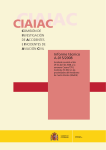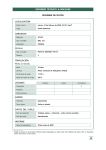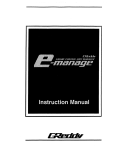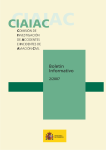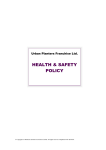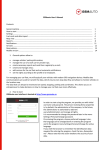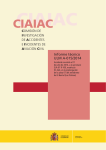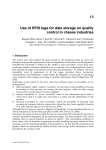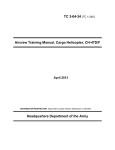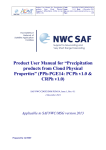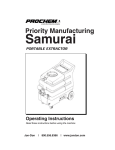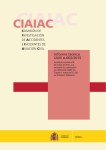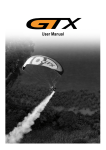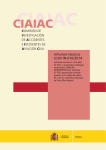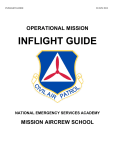Download fomento.es
Transcript
CIAIAC CIAIAC COMISIÓN DE INVESTIGACIÓN DE ACCIDENTES E INCIDENTES DE AVIACIÓN CIVIL Report A-015/2008 Accident involving a Cessna T310 aircraft, registration EC-DZV, in the vicinity of the Cuatro Vientos Aerodrome (Madrid), on 29 April 2008 Report A-015/2008 Accident involving a Cessna T310 aircraft, registration EC-DZV, in the vicinity of the Cuatro Vientos Aerodrome (Madrid), on 29 April 2008 SECRETARÍA DE ESTADO DE TRANSPORTES COMISIÓN DE INVESTIGACIÓN DE ACCIDENTES E INCIDENTES DE AVIACIÓN CIVIL Edita: Centro de Publicaciones Secretaría General Técnica Ministerio de Fomento © NIPO: 161-10-210-9 Depósito legal: M. 23.129-2003 Diseño y maquetación: Phoenix comunicación gráfica, S. L. COMISIÓN DE INVESTIGACIÓN DE ACCIDENTES E INCIDENTES DE AVIACIÓN CIVIL Tel.: +34 91 597 89 63 Fax: +34 91 463 55 35 E-mail: [email protected] http://www.ciaiac.es C/ Fruela, 6 28011 Madrid (España) Foreword This report is a technical document that reflects the point of view of the Civil Aviation Accident and Incident Investigation Commission (CIAIAC) regarding the circumstances of the event and its causes and consequences. In accordance with the provisions of Law 21/2003 and pursuant to Annex 13 of the International Civil Aviation Convention, the investigation is of exclusively a technical nature, and its objective is not the assignment of blame or liability. The investigation was carried out without having necessarily used legal evidence procedures and with no other basic aim than preventing future accidents. Consequently, any use of this report for purposes other than that of preventing future accidents may lead to erroneous conclusions or interpretations. This report was originally issued in Spanish. This English translation is provided for information purposes only. Report A-015/2008 Table of contents Abbreviations ................................................................................................................................ vi Synopsis ......................................................................................................................................... vii 1. Factual information ............................................................................................................... 1.1. 1.2. 1.3. 1.4. 1.5. 1.6. 1 History of the flight ........................................................................................................ Injuries to persons .......................................................................................................... Damage to aircraft ......................................................................................................... Other damage ................................................................................................................ Personnel information .................................................................................................... Aircraft information ........................................................................................................ 1.6.1. Aircraft documentation ..................................................................................... 1.6.2. Previous incidents .............................................................................................. 1.6.3. Airworthiness Certificate ................................................................................... 1.6.4. Cessna T310Q User’s Manual ........................................................................... 1.6.5. Fuel system ....................................................................................................... 1.6.6. Fuel consumption .............................................................................................. Meteorological information ............................................................................................ Aids to navigation .......................................................................................................... Communications ............................................................................................................ Aerodrome information .................................................................................................. Flight recorders .............................................................................................................. Wreckage and impact information ................................................................................. Medical and pathological information ............................................................................ Fire ................................................................................................................................. Survival aspects .............................................................................................................. Tests and research ......................................................................................................... Organizational and management information ................................................................ Additional information ................................................................................................... 1.18.1. Eyewitness statements ..................................................................................... 1.18.2. Information of flying conditions with a single engine operational .................. Useful or effective investigation techniques ................................................................... 1 1 2 2 2 4 5 6 6 7 8 11 11 12 12 13 13 13 15 15 15 15 16 16 16 17 18 2. Analysis .................................................................................................................................. 19 3. Conclusions ............................................................................................................................ 23 3.1. 3.2. Findings .......................................................................................................................... Causes ........................................................................................................................... 23 24 Safety recommendations ...................................................................................................... 25 Appendices .................................................................................................................................... 27 Appendix 1. Fuel system on the Cessna T310Q ...................................................................... 29 1.7. 1.8. 1.9. 1.10. 1.11. 1.12. 1.13. 1.14. 1.15. 1.16. 1.17. 1.18. 1.19. 4. v Report A-015/2008 Abbreviations 00° 00 °C AEMET AESA AGL ARO AIS AMC CIAIAC CPL(A) DGAC FAA FE FE(A) FI(A) ft GS h hPa IAS app ICAO IFR IR IR(A) IRI IRE(A) JAR-FCL KCAS KIAS kg/h kg/l km kt lb lb/h LECU LH LL m mb ME MEP MPH MTOW OEI PPL(A) QNH RH S/N SAMUR SE SID SUMMA TWR UTC VFR vi Degrees Degrees centigrade Spain’s National Weather Service Spain’s State Agency for Aviation Safety Above Ground Level Air Traffic Services Reporting Office Aeronautical Information Service Aviation Maintenance Center Comisión de Investigación de Accidentes e Incidentes de Aviación Civil (Spain’s Civil Aviation Accident and Incident Investigation Commission) Commercial Pilot License (Airplane) Dirección General de Aviación Civil (Spain’s Civil Aviation Authority) Federal Aviation Administration Flight Examiner Flight Examiner (Airplane) Flight Instructor rating (Airplane) Feet Ground Speed Hour(s) Hectopascal(s) Indicated airspeed on approach International Civil Aviation Organization Instrument Flight Rules Instrument flight Rating Instrument flight Rating (Airplane) Instrument Rating Instructor Instrument Rating Examiner (Airplane) Joint Aviation Regulations - Flight Crew Licensing Knots of Calibrated Airspeed Knots of Indicated Airspeed Kilos per hour Kilos per liter Kilometer(s) Knot(s) Pound(s) Pounds per hour Airport code for the Cuatro Vientos Aerodrome Left Hand Low Lead Meter(s) Milibar(s) Multi-Engine Multi-Engine Piston rating Miles Per Hour Maximum Take-Off Weight One Engine Inoperative Private Pilot License (Airplane) Atmospheric Pressure (Q) at Nautical Height Right Hand Serial Number Local Emergency and Rescue Service Single Engine Supplemental Inspection Document Emergency Medical Services Comunidad de Madrid Control tower Universal Coordinated Time Visual flight rules Report A-015/2008 Synopsis Owner and operator: Private Aircraft: CESSNA T310Q, S/N 0059 Date and time of accident: 29 April 2008; 9:05 UTC1 Site of accident: Vicinity of Cuatro Vientos Aerodrome, from the downwind to the base leg Persons onboard: 2, deceased Type of flight: General Aviation – Flight training – Proficiency check Date of approval: 27 October 2010 Summary of accident On 29 April 2008, the aircraft, a Cessna T310Q, was on a check flight at the Cuatro Vientos Aerodrome (LECU). Onboard were two people, the examiner and the pilot being tested. The aircraft had taken off at 08:22 and had conducted a flight lasting approximately one hour. At 09:02, the aircraft reported to the tower that it was on the downwind leg of the approach pattern to the aerodrome. A few minutes later it failed to reply to a call from the tower. The aircraft had impacted the ground on the final downwind leg, striking an area flanked by the M-40 and R-5 motorways. Both aircraft occupants were killed by the impact and the aircraft destroyed. 1 All times in this report are expressed in UTC. To obtain local time, add two hours to UTC time. vii Report A-015/2008 1. FACTUAL INFORMATION 1.1. History of the flight On 29 April 2009, the occupants of aircraft EC-DZV were on a proficiency check flight. Onboard were the examiner and the pilot being tested for the purpose of renewing the latter’s multi-engine (ME) and instrument (IR) ratings. The aircraft had not flown since 7 April, on which day it flew for about one hour, and had not been refueled since 31 March, on which day it had made one flight, also lasting about one hour, following the refueling. On the day of the accident, at about 08:09, the aircraft contacted LECU ground control to request clearance to taxi and, according to tower records, took off at 08:22. At 08:27, EC-DZV reported that it was over point W2. At about 08:59, aircraft EC-DZV reported that it was over point S3 at the entrance to the field, and at about 09:02 it reported that it was entering the left downwind leg for runway 28. At 09:04, the preceding aircraft, which had just landed, reported on the ground frequency that it had seen an airplane “doing strange things on downwind”. The controllers looked for the airplane visually but could not find it, after which they started calling it on the clearance frequency. They received no reply, and proceeded to notify emergency services. At 09:14 another aircraft in the aerodrome pattern reported that an airplane had crashed next to the M-40. At 09:22, a SUMMA helicopter reported that there were no survivors. The figure 14 shows the positions of the aircraft as detected by radar and its final position after impact. 1.2. Injuries to persons Injuries Fatal Crew 2 Passengers Total in the aircraft Others 2 Serious Minor Not applicable None Not applicable TOTAL 2 3 4 2 2 Reporting point in accordance with the Departure Procedure for the Visual Approach Pattern at Cuatro Vientos. Reporting point in accordance with the Arrival Procedure for the Visual Approach Pattern at Cuatro Vientos. Image obtained from Google Earth. 1 Report A-015/2008 Figure 1. 1.3. Radar positions (dots) for aircraft prior to impact Damage to aircraft The aircraft was destroyed as a result of the impact. 1.4. Other damage There was no additional damage. Since the aircraft impacted at the junction of the M40 and R-5 motorways, the R-5 access road was cut off so as to allow crews to extract the bodies from the aircraft in preparation for accessing the aircraft and removing it from the site. 1.5. Personnel information The examinee, seated in the LH seat, was 29 years old and a Spanish national. He had a valid and in force commercial pilot license (CPL (A)) with the following ratings: • ME piston (Land), valid until 17/05/2008 • SE piston (Land), valid until 17/05/2008 2 Report A-015/2008 • Airplane instrument rating (IR (A)), valid until 17/05/2008 • Airplane flight instructor (FI (A)), valid until 23/05/2008 • Radio operator proficient in English He had a valid and in force Class 1 medical certificate. According to information noted in the pilot logbook, the last entry was dated 27/02/2008 and recorded a total experience of 780 flight hours, of which 33 were on twin-engine airplanes, 29 of them while practicing for his rating in 2004 and one hour a year to renew the rating. The twin-engine airplane used to log all of these hours had been a PIPER PA-34 SENECA. The examiner, who was in the RH seat, was 41 years old and a Spanish national. He had a valid and in force commercial pilot license (CPL (A)) and had the following ratings: • • • • • • • ME piston (Land), valid until 08/08/2008 SE piston (Land), valid until 08/08/2009 Airplane instrument rating (IR (A)), valid until 16/11/2008 A320 (COPILOT), valid until 16/11/2008 Airplane flight instructor (FI (A)), valid until 08/08/2007 Instrument rating instructor (IRI), valid until 08/08/2007 Radio operator proficient in English He also had a language proficiency Certificate (document associated with the CPL (A) license), equivalent to Level 4 (as per ICAO Annex I), valid until 04/03/2011. He had a valid and in force Class 1 medical certificate. In addition, he held a Flight Examiner Authorization (airplane) issued by Spain’s civil aviation authority (the DGAC, now known as AESA) to conduct skill tests and proficiency checks associated with the Flight Examiner (FE (A)) rating. He was also a certified Instrument Rating Examiner (IRE (A)), valid until 5/12/2008 unless otherwise canceled, suspended or revoked. In accordance with the stipulations of this authorization, the authorized examiner must fulfill and maintain all the prerequisites necessary for said authorization. Item 1.425 of the JAR FCL 1 regulations on flight crew licensing establishes the following: JAR-FCL 1.425 Examiners-General (a) Pre-requisites (1) Examiners shall hold a licence and rating at least equal to the licence or rating for which they are authorised to conduct skill tests or proficiency 3 Report A-015/2008 checks and, unless specified otherwise, the privilege to instruct for this licence or rating. (2) Examiners shall be qualified to act as pilot-in-command of the aircraft during a skill test or proficiency check, unless otherwise specified, and shall meet the applicable experience requirements set out in JAR-FCL 1.435 through 1.460. Where no qualified examiner is available and, at the discretion of the Authority, examiners/inspectors may be authorised without meeting the relevant instructor/type /class rating requirements as mentioned above. (d) Entries in the licence. In licences where revalidation entries may be made by the examiner, the examiner will: (1) complete the following details: ratings, date of check, valid until, authorisation number and signature; (2) submit the original of the skill test/proficiency check form to the issuing Authority and hold one copy of the check form on personal file. According to this last point, once performed the skills or rate checking tests, the examiner must send the original form to AESA. This agency must deal with and update the renewal of licenses. AESA has a licenses and ratings computerized database for this purpose. The Logbook detailing the examiner’s flight hours was not available. The information that was available in terms of flight experience involved his hours as an A-320 copilot, with 932:06 flight hours, and that obtained as a flight instructor which, according to information received over the course of the investigation, totaled 4,203 h in piston engines as of 2006. According to records found on the aircraft for the time period starting in June 2007 up to the date of the accident, the aircraft had been used almost exclusively by the examiner over the course of some 41 h. The examiner had conducted several exams on previous dates and had another exam scheduled following the conclusion of the accident flight. 1.6. Aircraft information The aircraft, a Cessna T310Q, registration EC-DZV, serial number 0039 and manufactured in 1969, was a twin-engine retractable gear aircraft with two turbocharged Continental TSIO-520-B engines, S/N 165332-7-B /182960, and a three-blade McCauley propeller, 3AF32C87-NR/S82NC-4 (see Figure 25). 5 Image obtained from jetphotos.net. 4 Report A-015/2008 Figure 2. 1.6.1. General view of aircraft Aircraft documentation The aircraft had the necessary administrative documentation, though the documents were not inside the aircraft, but instead were in possession of its owner. The Spanish registration certificate was valid and had been issued on 21 May 2003. The airworthiness certificate for a normal category airplane had been issued on 17 November 2004 and was valid until 31 May 2008. The aircraft also had an Aircraft Station License valid until 31/05/2008 and an Insurance Certificate valid until 30 January 2009, which reflected its use as a Club aircraft, including school and rental activities. Also associated with the aircraft was a Maintenance Program, which stated: Note 1: a “yearly inspection” is to be performed each calendar year and will include performance of the 50-, 100- and 200-hour inspections if not completed due to insufficient hours. The engine and aircraft logbooks were not recovered. They were not found inside the aircraft, where the owner assured they had to be. The maintenance center responsible 5 Report A-015/2008 for doing the last annual inspection (corresponding to the renewal of its Airworthiness Certificate) also had no knowledge of their location. Flight reports were found inside the aircraft recording the flights made by the aircraft by date, with times for engine start-up, takeoff, landing, engine stop and the name of the pilot who had made the flight, as well as each flight’s initial and final hour meter reading. With some exceptions, all of the flights made agreed with those recorded at the Cuatro Vientos ARO/AIS Office, according to which this aircraft had flown 42 hours since the renewal of its Airworthiness Certificate. 1.6.2. Previous incidents The aircraft had been involved in two previous incidents, one in 1998 which damaged its landing gear (IN-013/98-BIS, included in Bulletin 2/98) and another in 2004 that was not reported to the CIAIAC and in which its propellers struck the ground, requiring a subsequent special inspection of the left engine due to a propeller strike and a repair and overhaul of the right engine. Two new propellers also had to be installed. These tasks were performed in September 2004, and the aircraft had flown on a more or less regular basis since that date without any reported anomalies of the engines or propellers. 1.6.3. Airworthiness Certificate The Airworthiness Certificate was renewed on 31 May 2007 with 4239:55 total hours on the aircraft. According to information at Flight Safety Office No. 6 at Madrid Cuatro Vientos, the documentation provided was in order. A handwritten note on this documentation stated: Supplementary Inspections (SIDs6) must be performed prior to November 2007 - AMC notified to inform owner for compliance. In the Request for Renewal of Airworthiness Certificate issued by the maintenance center, there was no mention of the requirement to satisfy the SIDs when stating that each and every one of the conditions for the continued validity of the Airworthiness Certificate was met. The owner stated that he was unaware of the need to perform these inspections. Among the documentation provided by the maintenance center to the Flight Safety Office was a photocopy of the first page listing the SIDs and which stated that the inspections had to be completed prior to 1 November 2007. These inspections were never performed. 6 Supplemental Inspection Document are inspections to be performed on the aircraft after a certain number of years to ensure that its structure is free from the effects of material fatigue. SIDs are equivalent to Airworthiness Limitations. 6 Report A-015/2008 1.6.4. Cessna T310Q User’s Manual According to the aircraft’s User’s Manual, before engine start-up, a pre-flight inspection must be done which includes a walk-around inspection of the aircraft to check its general condition. Among other items, the fuel level in each tank must be physically verified by opening the corresponding tank and looking at the fuel level inside. In the case of the auxiliary tanks, the inspection can be direct because they are close to the cockpit access doors. In the case of the main tanks, a ladder or a dipstick must be used to carry out this check. In addition, all of the tanks must be drained if any impurities or water have accumulated inside. It is not known whether the aircraft occupants performed said visual check, and thus whether they checked the actual fuel level. The before-landing checks, both for normal and engine failure conditions, are as follows: Before landing: (1) Fuel Selectors(2) (3) (4) (5) (6) (7) (8) (9) (10) (11) Left engine- LEFT MAIN (feel for detent) Right engine- RIGHT MAIN (feel for detent) Auxiliary Fuel Pumps- ON Alternate Air Controls- Check IN Mixtures- FULL RICH or lean as required for smooth operation. Propellers- FULL FORWARD Wings Flaps- DOWN 15° below 160 KCAS Landing Gear- DOWN below 146 KCAS Landing Gear Position Indicator Lights- Check down lights- ON; Unlocked light- OFF Wings Flaps- DOWN 15° to 35° below 140 KCAS Minimum Multi-Engine Approach Speed- 94 KCAS Minimum Single-Engine Control Speed - 81 KCAS Engine failure during flight: (1) Inoperative engine- DETERMINE (idle engine same side as idle foot) Before securing inoperative engine: (2) Fuel flow- CHECK, if deficient, position auxiliary fuel pump switch to ON NOTE: If fuel selector valve is in AUXILIARY TANK position, switch to MAIN TANK and feel for detent. (3) Fuel Quantity- CHECK,and switch to opposite MAIN TANK if necessary. (4) Oil pressure and Oil Temperature- CHECK, shutdown engine if oil pressure is low. (5) Magneto Switches- CHECK. 7 Report A-015/2008 If proper corrective action was taken, engine will restart. If it does not, secure as follows: (6) Inoperative engine - SECURE a) Throttle- CLOSE b) Mixture- IDLE CUT-OFF c) Propeller- FEATHER d) Fuel Selector- OFF e) Auxiliary Fuel Pump- OFF f) Magneto Switches- OFF g) Alternator- OFF h) Cowl Flap- CLOSE (7) Operative engine - SECURE a) Power- AS REQUIRED b) Mixture- ADJUST for power c) Fuel Selector- MAIN TANK (feel for detent) d) Auxiliary Fuel Pump- ON e) Cowl Flap- AS REQUIRED (8) Trim Tabs- ADJUST (5° bank toward operative engine) (9) Electrical Load- DECREASE to mínimum required. (10) As soon as practical- LAND. Single engine approach and landing: (1) (2) (3) (4) (5) (6) (7) 1.6.5. Mixture- FULL RICH. Propeller- FULL FORWARD Approach ta 98 KIAS with excesive altitude Landing gear- DOWN within glide distance of field. Wing Flaps- DOWN when landing is assured Decrease speed below 94 KIAS only when landing is assured Minimum Single Engine Control Spped- 81 KIAS Fuel system The fuel is supplied to each engine by a main tank (50-gallon usable capacity) on each wing tip and an auxiliary tank (20-gallon usable capacity) located in each wing outside the engine mount. Each engine has its own complete fuel system. They are interconnected by a cross-feed for emergency use. The vaporized fuel and the excess fuel that is not used by the engine is returned to the main tank even if the fuel used is from the auxiliary tank. Thus, the auxiliary tanks are vented to the main tanks, which in turn are vented to atmosphere. 8 Report A-015/2008 There are two fuel pumps inside each main tank: • A submerged electric auxiliary pump that supplies fuel for both priming and starting, and for engine operation as a back-up system to the engine driven pumps. (see Appendix I). There are two switch positions of these pumps: LOW and ON (HIGH) position. • Continuous duty tip tank transfer pumps installed in each main tank that ensure that the auxiliary pump is always submerged in fuel and supplies fuel to the engine in the event of high angles of descent. There are no pumps in the auxiliary tanks, which supply the fuel selectors directly. If the auxiliary tanks are to be used, select fuel from the main tanks for 60 minutes prior to switching to auxiliary tank: this is necessary to provide space in the main tanks for vapor and fuel returned from the engine-driven fuel pumps. If sufficient space is not available in the main tanks for this diverted fuel, the tanks can overflow through the vent line. Since part of the fuel from the auxiliary tanks is diverted back to the main tanks instead of being consumed by the engines, the auxiliary tanks will run dry sooner than may be anticipated. However, the main endurance will be increased by the returned fuel. The total usable fuel supply is available when during cruising flight only. An engine failure or engine driven pump failure will result in the auxiliary fuel on the side of the failure being unusable. Operation on the auxiliary fuel tanks near the ground (below 1,000 ft AGL) is not recommended. The User’s Manual also states that whenever the fuel tank selection is changed, the mixture must be full rich and the auxiliary pumps must be in the LOW position. The fuel selector handles are located on the cockpit floor between the two seats. The handles provide an input to the fuel selector valves, located one inside each wing (see Figures 3 and 4). Figure 3. Fuel selector handles in the cockpit of an aircraft similar to that involved in this accident 9 Report A-015/2008 Figure 4. Fuel selectors inside the wings of the accident aircraft The possible positions of the handle in the cockpit are listed below: Left engine Right engine OFF- not supplied OFF- not supplied LEFT MAIN- left main tank RIGHT MAIN- right main tank LEFT AUX- left aux tank RIGHT AUX- right aux tank RIGHT MAIN- right main tank (crossfeed) LEFT MAIN- left main tank (crossfeed) The following note is contained in the fuel section of the User’s Manual: The fuel selector valve handles should be turned to LEFT MAIN for the left engine and RIGHT MAIN for the right engine, during take-off, landing and all emergency operations. When fuel selector valve handles are changed from one position to another, the auxiliary fuel pumps should be switched to LOW, the mixture should be in FULL RICH and the pilot should feel for detent to ensure that the fuel selector valve is properly positioned. The LOW position on the auxiliary fuel pump switch is used for the low-speed operation of the pumps. The ON position runs the auxiliary fuel pumps at low speed, so long as the engine driven pumps are functioning. With an engine-driven pump failure and the switch in the ON position, the auxiliary pump on that side will switch to high speed automatically, providing sufficient fuel for all engine operations including emergency takeoff. If the auxiliary pumps switches are positioned to ON for a period in excess of 60 seconds with engines inoperative on the ground or during flight (feathered), the engines and/or the aircraft may be damaged due to fuel accumulations in the induction system. 10 Report A-015/2008 1.6.6. Fuel consumption A rough estimate of the fuel consumed by the aircraft can be made by taking into account the tables in the User’s Manual, the notes in the flight logs, the refueling records and the ARO7 office records. So as to have the results be as close as possible to reality, the calculations were made by comparing the dates and the amounts taken on during the refuelings to the hours flown in those periods. Also, a date well enough in advance of the accident was used so as to take into account the possibility that some fuel remained from other refuelings, as well as to ensure that all of the flights made since that date had been made by the same person, namely the examiner. According to the Maintenance Manual, the main tanks have a usable capacity of 100 gallons and the auxiliary tanks 40, for a total of 140 gallons (529.9 liters). For the purpose of the fuel usage calculations, an average density of 0.71 kg/l was used for 100 LL aviation fuel and an average consumption of 150 lb/h (68.1 kg/h). Data provided by the fuel supplier, along with the hour meter readings noted in the flight logs, show that: • On 16/10/2007, 353 liters were refueled, equivalent to (considering the average data specified above) 3 hours and 40 minutes. After that refueling, several flights were made lasting a total of 3 hours and 48 minutes. • On 27/12/2007, 264 liters were refueled, equivalent to 2 hours and 45 minutes. After that refueling, several flights were made lasting a total of 4 hours and 54 minutes. • On 29/02/2008, 372 liters were refueled, equivalent to 3 hours and 52 minutes. After that refueling, several flights were made lasting a total of 4 hours and 6 minutes. • On 31/03/2008, the date of the last refueling, 290 liters were taken on, equivalent to 3 hours and 1 minute. After that refueling, several flights were made lasting a total of 2 hours and 6 minutes. If the time corresponding to the accident flight is added, that would be an additional one hour, resulting in a total of 3 hours and 6 minutes. The notes made by the examiner in the flight logs were very detailed. On 31 March, in the columns in the flight log where the name of the pilot making the flight was listed and there was also “Fuel” written down. It should be noted that the airplane had been refueled prior to that day’s flight (which lasted about one hour), and not after. 1.7. Meteorological information According to Spain’s national weather service (AEMET), the weather information for LECU on the day of the accident was as follows: 7 ARO. Air traffic services reporting office. 11 Report A-015/2008 • 1030 UTC. Wind 230°, 10 kt, varying between 200° and 260°, visibility in excess of 10 km, clear skies, temperature 15 °C, dewpoint 1 °C. QNH, 1,012 hPa. • 1100 UTC. Wind 210°, 9 kt, varying between 160° and 260°, visibility in excess of 10 km, clear skies, temperature 15 °C, dewpoint 1 °C. QNH, 1,012 hPa. The information provided by the TWR just prior to the accident reported a QNH of 1,013 mb and wind at 8 kt from 230° gusting at 12 kt. 1.8. Aids to navigation Not applicable. 1.9. Communications The communications available include those held between the occupants of the aircraft and the Cuatro Vientos control tower, which are summarized below: • At 08:09:40, the aircraft contacted LECU ground, reporting their parking position, their intention to make a one-hour local flight and requested taxi instructions. • At 08:26:59, EC-DZV reported it was over point W. • At 09:00:00, EC-DZV made a 360° turn above point S at the request of TWR to avoid nearby traffic. • At 09:01:53, TWR notified EC-DZV to exercise caution when joining the pattern due to traffic on the downwind leg and requested that, if possible, it make a wide pattern. The aircraft replied that it had the traffic in sight and that it was joining the pattern behind it. This would be the last communication with TWR. • At 09:04:00, the aircraft that had just landed, callsign FYS141, reported on the ground frequency that it had just seen from its position “an airplane on downwind doing some strange things”. • At 09:05:06, TWR cleared EC-DZV to land. There was no reply from the aircraft. From that moment on, repeated calls were made to EC-DZV and an emergency was declared. • At 09:14, another aircraft in the aerodrome pattern reported that an airplane had crashed next to the M-40 motorway. • At 09:22, a SUMMA helicopter reported that there were no survivors. 12 Report A-015/2008 1.10. Aerodrome information The Cuatro Vientos aerodrome (LECU) is located 8.5 km away from the city of Madrid (40° 22’14” N, 3° 47’07” W), at an elevation of 2,269 ft. Both military and civil aviation traffic operating under visual flight rules (VFR) are authorized. There is one 1,500-meter long, 30-meter wide asphalt runway in a 10/28 orientation. On the day of the accident, the runway in use was 28. The aerodrome’s pattern for civilian traffic is to the south of the field, at an altitude of 2,925 ft. Figure 5. AD traffic circuit The location of the Cuatro Vientos aerodrome is unique in that it is surrounded by numerous developed and inhabited areas, meaning that not much of the surrounding land is clear or suitable for an emergency landing (see Figure 1). 1.11. Flight recorders There were no flight recorders onboard nor were they required for this type of aircraft. 1.12. Wreckage and impact information The aircraft was found on a small field flanked by the R-5 and the on-ramp to said motorway from the M-40. The wreckage was confined to a small area. The aircraft showed signs of having impacted at a high angle with respect to the horizontal. Neither the nose of the aircraft nor the cockpit were visible. The remaining airframe and the tail section did not show any signs of an impact and there were no drag marks on the ground. The nose was oriented toward 130° (see Figure 6). 13 Report A-015/2008 Figure 6. Condition of the aircraft after the impact One of the firemen who took part in extracting the bodies and who had a knowledge of aviation reported smelling barely any fuel when he arrived at the scene. The main tanks were destroyed. Only beneath the left wing was some moisture noticeable on the ground under the main tank. The landing gear was deployed and the flaps were extended to about 15°. The propellers had dug into the ground and one blade on both sides was buried in the dirt. The buried blade on the left propeller was found torn from its hub, under the engine and facing backwards with respect to the rest of the aircraft. The buried blade on the right propeller had broken near its attachment to the hub. In general, none of the blades showed any signs of having impacted the ground at power and none were in a feathered position (see Figure 7). In the cockpit, the alternators and magnetos were ON and the auxiliary fuel pumps were also ON. All the levers were full forward: the throttle, mixture and propeller (low pitch). The engine cowl flaps were open. The gear handle was selected to the gear down position. The flaps were set at 15°. The fuel control handles were selected to the auxiliary tanks (LEFT AUX and RIGHT AUX). No reliable information was available for the remaining systems and gauges due to their condition. The propellers and engines were retrieved for subsequent analysis and inspection. The fuel selector valves inside the wings, along with the fuel pumps in both main tanks (transfer and auxiliary pumps), were also retrieved for a follow-up inspection. 14 Report A-015/2008 Figura 7. 1.13. General view of aircraft propellers Medical and pathological information The autopsy reports on the two passengers were not available. 1.14. Fire There was no fire after the impact. 1.15. Survival aspects Given the characteristics of the accident, it was practically impossible for the occupants to have survived. Although it probably would not have improved their chances of survival, information gathered over the course of the investigation revealed that the harnesses used in the aircraft were two-point belts, meaning that the occupants were only restrained by the waist. 1.16. Tests and research During the visual inspection of the aircraft wreckage in the field, and since the blades of both propellers had dug into the ground but without any apparent signs of having impacted the ground at power, it was decided to submit the engines to a more 15 Report A-015/2008 exhaustive analysis in the workshop. This inspection revealed no anomalies or defects that could have caused an engine stoppage. Only certain maintenance deficiencies were noted that could have resulted in the engines performing at less than 100%. When the engines were removed from their respective mounts, and subsequently, during the inspection of the fuel system, there was barely any fuel in the piping supplying the engines or in the fuel distributors. A more detailed inspection of the fuel system and all of its components was conducted. The piping and the selectors barely had any fuel. The main fuel tanks were then examined. The inlet to the right tank transfer pump was blocked by deposits from the fuel tank. The left tank transfer pump was not blocked. No internal anomalies were detected that would have resulted in an improper operation of the pumps, though the sealing joints in both pumps were not approved. There were no signs, however, of any leakage. The auxiliary pumps were sent to the manufacturer for their inspection and disassembling to check their condition and operation. An operational test was conducted to check flow rates and electric current draw in the pump motors. The pumps were then disassembled. The results of this inspection confirmed that the auxiliary pumps satisfied the requirements of the operational test, save for a slight increase in the current drawn by the left tank pump. During the internal inspection a swelling of the potting was noted. Normally, such swelling appears in pumps that are running dry (without fuel) for a certain period of time. Without a flow of fuel to cool the armature, the wires will expand, pushing out the potting and resulting in greater friction and resistance to rotation, meaning more current is required to maintain the fuel flow to the engine. Neither the fuel selectors nor their connections were blocked. Their position was consistent with those selected on the cockpit fuel selector handles. Both engines were selected to the auxiliary tanks. No evidence was found of a structural failure in the aircraft involving those components that should have been inspected by the SIDs. 1.17. Organizational and management information Not applicable. 1.18. Additional information 1.18.1. Eyewitness statements A pilot who had just landed on runway 28 explained how, while taxiing, he saw an aircraft on the downwind leg doing something strange and notified ground control of this. The eyewitness reported seeing a strange maneuver, as if a wing had risen suddenly. 16 Report A-015/2008 Another eyewitness with aviation experience reported that as he was driving toward the M-45, on the extension of what would be the base leg on the LECU pattern to the south, he saw how the aircraft, which was flying low and presumably on base, pitched up, turned to the right and then backwards. He did not see the aircraft fall. Several other eyewitnesses said that the aircraft was flying low and that it made a strange maneuver, plunging to the ground and kicking up a large cloud of dust at the impact site. 1.18.2. Information on flying conditions with a single engine operational On 29 April 2005, the Federal Aviation Administration (FAA) issued a Special Airworthiness Information Bulletin (CE-05-51) which alerted owners and operators of piston multi-engine aircraft of conditions which could render level flight impossible with one engine inoperative (OEI) and a windmilling propeller. An aircraft’s performance is determined by the amount of available power and the total aircraft drag. The amount by which the power exceeds the difference between these two determines the aircraft’s ability to climb. The loss of an engine in a piston multiengine aircraft dramatically reduces the amount of available power. The following figures show the relationship between drag and available power with both engines operating and with OEI. The green curve represents the power available versus the orange total drag curve. The difference between them would represent the airplane’s ability to climb. Figure 8. Both engines operatives Figure 9. One engine inoperative 17 Report A-015/2008 The OEI climb performance is affected by weight, altitude, temperature and aircraft configuration. The usual aircraft configuration for maximum OEI climb performance is as follows: • • • • • Operating engine at full throttle Landing gear up Flaps retracted The inoperative engine propeller is feathered Wings banked 5° toward operative engine. The inability to maintain level flight is exacerbated by a windmilling propeller, which generates large amounts of parasitic drag. In the case of a piston multi-engine airplane, the effect of a windmilling propeller is to increase the total drag of the airplane and induce an asymmetric drag about the yaw axis. The net result of a windmilling propeller is the aircraft total drag exceeds the power available, thus the aircraft is no longer able to sustain level flight. 1.19. Figure 10. Useful or effective investigation techniques Not applicable. 18 Total drag with a windmilling propeller Report A-015/2008 2. ANALYSIS The aircraft occupants were conducting an instrument rating (IR) and multi-engine proficiency (MEP) flight lasting one hour. The aircraft had not been refueled that day. It had been refueled about a month earlier and only two flights lasting about one hour each had been made. The flight logs filled out by the pilots flying the aircraft included the note “Fuel” on the day of the last refueling, but without referencing the fact that the airplane had been refueled prior to that day’s flight. The examinee was in the LH seat and the examiner in the RH seat. When both pilots’ licenses were checked, it was noted that the examiner’s license was valid, though the Flight Instructor (FI) and Instrument Rating Instructor (IRI) ratings had expired. The examiner’s authorization issued by AESA to the examiner was valid in 2008, but subject to compliance with the prerequisites for obtaining said authorization. According to JAR FCL 1 regulations on flight crew licensing, the section on examiners states that they must have a license and rating at least equal to the license or rating for which they are authorized to conduct skill tests or proficiency checks and, unless otherwise specified, the privilege to instruct for this license or rating. In other words, both instruction ratings must be valid (in addition to the ratings being checked on the examination) in order for the examiner’s authorization be valid. Therefore, the Examiner’s authorization became void on the date these ratings expired. Despite this, the examiner had conducted several other examinations without AESA realizing that he was not administratively qualified to do so. This has prompted the issuance of a safety recommendation in this regard, as discussed later, taking into consideration, as previously indicated, that AESA has a computerized database with which the fulfilment status of the examiner conditions could be made, as an extra requirement during the licenses renewal of the examinees they are checking. The examinee had no experience on that aircraft, and the examiner had 41 hours that could be verified. This could have influenced the speed with which the immediate actions were carried out when the engine problems began. The aircraft’s Airworthiness Certificate was valid until May 2008, and was contingent upon compliance with the Airworthiness Limitations. The aircraft had to undergo a series of inspections (SIDs) that had to be conducted prior to 1 November 2007. Since these inspections were not performed, the Airworthiness Certificate would have expired on that date. Despite this, there was no evidence of a structural failure that could have caused the accident. As for the occupants’ flight preparation and planning, there is no record of the preflight inspection having been performed and, in particular, that the actual level of fuel available in all of the tanks was checked or that they were drained. The notes made in 19 Report A-015/2008 the flight logs had apparently given the impression that there was sufficient fuel for at least two more flights. According to the fuel records and calculations presented earlier, the airplane had been refueled with 264 liters on 27/12/2007, equivalent to 2 hours and 45 minutes. Following that refueling several flights were made lasting a total of 4 hours and 54 minutes. It was probably during that time when any available leftover fuel was practically exhausted. The last refueling was on 31/03/2008, when 290 liters were added, equivalent to 3 hours and 1 minute. Following that refueling several flights were made lasting a total of 2 hours and 6 minutes, not including the time corresponding to the accident flight which, according to tower records, would add an additional hour, the total thus being 3 hours and 6 minutes. The auxiliary pumps were selected to ON (this is accomplished with the before landing procedure if an engine fails before securing the inoperative engine if the fuel flow is deficient). The User’s Manual also states that if they are left on for more than 60 seconds with an engine inoperative, the engine can be damaged by the build-up of fuel in the induction system. It also states that when the fuel tank selection is changed, the auxiliary pumps must be in LOW and the mixture must be full rich. Although the User’s Manual explicitly states that the main fuel tanks on both engines must be selected during takeoff and any emergency operation, the auxiliary fuel tanks were selected by the aircraft’s occupants. As noted previously, the auxiliary pumps were selected but, knowing that these pumps are in and draw a suction on the main tanks, and that the tanks selected were the auxiliary tanks, these pumps were only pressurizing the fuel contained in the piping connecting the main tank to the fuel selector, which was closed and therefore there was no connection with the engine. Furthermore, the fuel supplied from the tanks selected (auxiliary) and not used in the engine would be returned to the main tanks, resulting in increased auxiliary tank fuel consumption. This demonstrates a lack of knowledge on the part of the occupants regarding the fuel system and its management. A subsequent inspection of the auxiliary pumps revealed that one (in the left tank) showed clear signs of having been operating dry (without any fuel). The supply to the transfer pump in the right tank was blocked with deposits from the fuel tank. This is evidence of a lack of fuel in the main tanks. In general, none of the propellers showed any obvious deformation indicative of having impacted the ground at power, and none were feathered (position that should be selected after an engine stoppage). The condition of the propellers and the evidence found in the auxiliary pumps in both tanks points to a probable stoppage of both engines, one after the other. Based on the conversations held with the Tower during their entry into the pattern, at no time did the aircraft occupants indicate that they were in need of landing 20 Report A-015/2008 immediately or that they were having technical problems or were short on fuel. This despite being asked by the Control Tower on two occasions to delay their arrival by doing a 360 and a wide pattern before entry into the sequence for landing. The first engine probably started to sputter after the aircraft joined the pattern (on the downwind leg), after reporting to the Tower that they were entering behind another aircraft and with the before landing checklist completed. It was then that a pilot on the ground saw a strange and sudden maneuver (possibly a yaw resulting from the lack of power to an engine and the pilot’s attempt to correct it). The aircraft was configured for landing with the flaps deployed 15° and the landing gear down. The throttle, propeller and mixture levers were also full forward (landing configuration). As noted in Section 1.18.2, when faced with a one engine inoperative situation in a twin-engine aircraft, the inability to maintain level flight is exacerbated by a windmilling propeller on an inoperative engine, which generates large amounts of parasitic drag. In the case of a piston multi-engine aircraft, an un-feathered propeller would cause an increase in the total drag and induce an asymmetric drag about the yaw axis. The result of OEI with an un-feathered propeller is that the aircraft’s total drag is greater than the power available, meaning the aircraft is no longer able to maintain level flight. In this case, we must add the fact that the airplane was in a “dirty” configuration with the gear down and the flaps deployed, which would have increased the parasitic drag even more. In addition to the increased aircraft drag on the final portion of the downwind leg, there was probably the stoppage of the other engine, which led to a loss of control of the aircraft and its subsequent impact with the ground. 21 Report A-015/2008 3. CONCLUSION 3.1. Findings Based on the information gathered and on its analysis, the following conclusions can be drawn: • The occupants of the aircraft were qualified to fly it. • The examinee’s license was valid and in force. • The examiner’s license was valid and included the ratings required to fly this type of aircraft. • The examiner’s flight instructor and instrument flight instructor had expired. • The examiner’s authorization became void when the instructor ratings expired. • The examiner had conducted other check flights during the period when this authorization was no longer valid. • The aircraft’s Airworthiness Certificate had been voided on 1 November 2007 by the failure to comply with the SIDs. • The aircraft continued to fly after this date. • There was no evidence of a structural failure in general, or of the areas affected by the SID in particular. • On the date of the accident, the aircraft was being flown on a proficiency check lasting around one hour. • No fuel had been taken on that day. The aircraft had been refueled a month earlier with enough fuel for three hours. • Since then two more flights had been made, lasting approximately one hour each, not including the accident flight. • The note in the Flight Log concerning the last refueling did not specify whether the refueling had taken place before or after that day’s flight. • There is no record of the pre-flight inspection, which includes a physical check of the actual level in all the fuel tanks, having been performed. • The propellers showed no signs of having impacted the ground at power and none were feathered (as required after an engine stoppage). • The inspections did not reveal any signs of fuel remaining in the tanks, engines or fuel system. • The auxiliary fuel pumps were sent to the manufacturer for analysis. The left pump showed signs of having been run dry (without any fuel). • The suction to the transfer pump in the right tank was blocked by deposits from the fuel tank. • The auxiliary fuel tanks were selected. • The auxiliary pumps, which only pressurize the fuel in the main tanks, were selected to ON. • The User’s Manual states that the auxiliary pumps be selected to LOW with the main pumps selected before landing. • The aircraft was configured for landing with the flaps and gear deployed. The engine, propeller and mixture controls were all set to full for both engines. 23 Report A-015/2008 3.2. Causes The accident likely resulted from the fuel exhaustion of both engines, which caused them to stop. The first engine probably started to sputter after joining the pattern (on the downwind leg). The occupants’ belief that they could land on a single engine probably led them to continue to the base leg instead of performing an emergency landing. The impossibility of maintaining level flight with one engine inoperative and its propeller un-feathered, along with the “dirty” configuration of the aircraft, whose landing gear and flaps were deployed, resulted in a substantial increase in parasitic drag. A short while later the other engine stopped, causing the aircraft to dive and eventually impact the ground. 24 Report A-015/2008 4. SAFETY RECOMMENDATIONS The investigation revealed several deficiencies that, as detailed in the Analysis section, have prompted the issuance of the following safety recommendation: REC 04/10. It is recommended that AESA establishes all the necessary mechanisms directed to guarantee that all examiners qualified for checking the examinees flight skills and rating tests under authority supervision keep valid their licenses, ratings and certificates at the moment they perform their attributions. These mechanisms could be, but not limited to, specific requests and checkings in the computerized database containing the information of the examiners. 25 Report A-015/2008 APPENDICES 27 Report A-015/2008 APPENDIX 1 Fuel system on the Cessna T310Q 29 Report A-015/2008 31










































